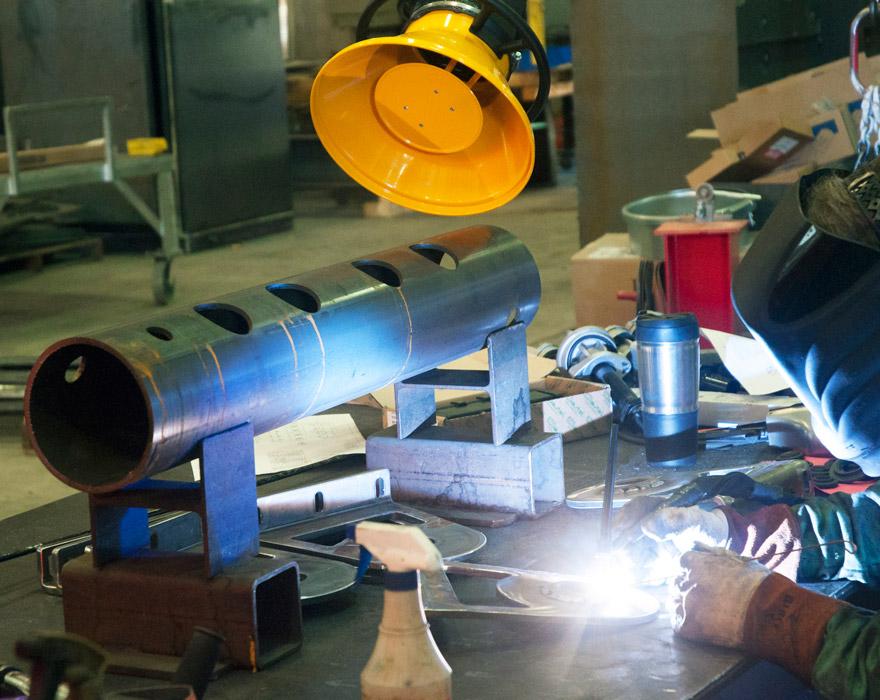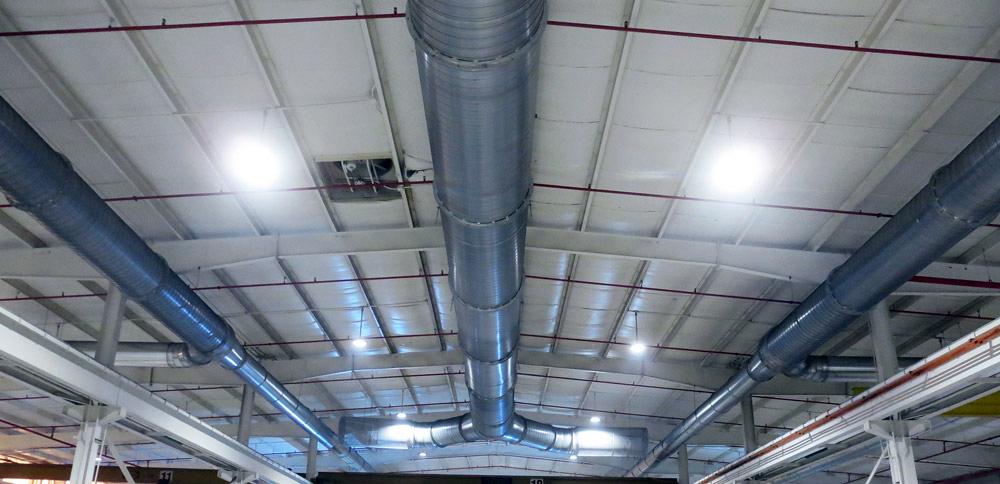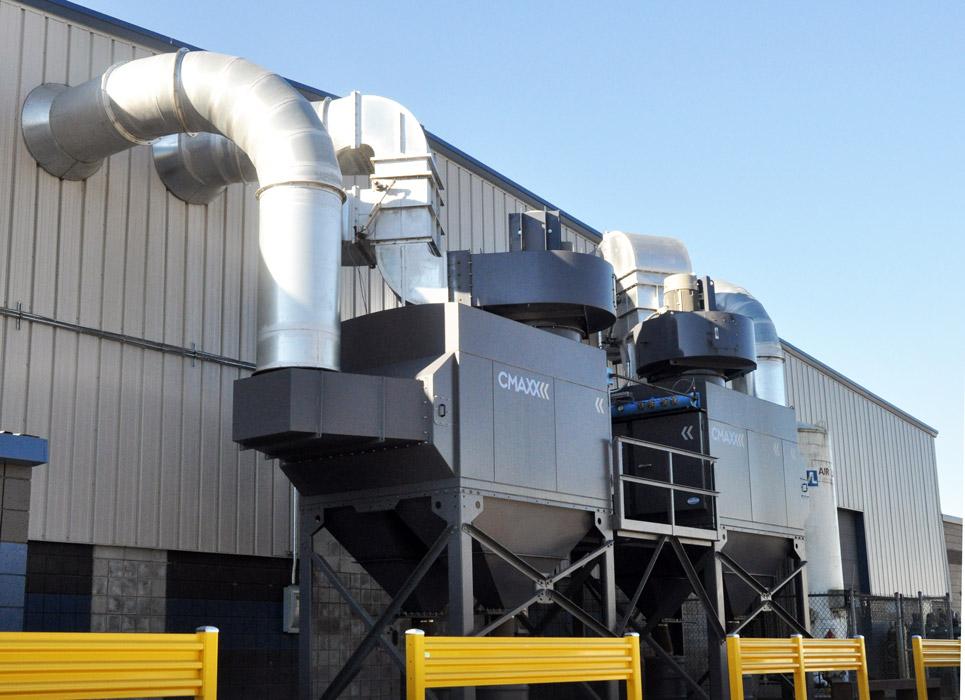President/CEO
- FMA
- The Fabricator
- FABTECH
- Canadian Metalworking
Categories
- Additive Manufacturing
- Aluminum Welding
- Arc Welding
- Assembly and Joining
- Automation and Robotics
- Bending and Forming
- Consumables
- Cutting and Weld Prep
- Electric Vehicles
- En Español
- Finishing
- Hydroforming
- Laser Cutting
- Laser Welding
- Machining
- Manufacturing Software
- Materials Handling
- Metals/Materials
- Oxyfuel Cutting
- Plasma Cutting
- Power Tools
- Punching and Other Holemaking
- Roll Forming
- Safety
- Sawing
- Shearing
- Shop Management
- Testing and Measuring
- Tube and Pipe Fabrication
- Tube and Pipe Production
- Waterjet Cutting
Industry Directory
Webcasts
Podcasts
FAB 40
Advertise
Subscribe
Account Login
Search
The 3 challenges of managing welding fumes
A properly designed ventilation setup can keep employees and the shop safe and productive
- By Jeremiah Wann
- November 29, 2016
- Article
- Safety

Figure 1
Point-of-source capture units like this portable collector with an extended arm are suitable for shops that have small welding operations and don’t necessarily weld in one particular area.
Welding fumes can pose a serious health threat, and they can also present their own problems for an air quality control system. In deciding how to manage welding fumes in your facility, you need to consider several situational factors and the welding equipment being used, both of which will influence just how the end goal is met.
What are some of these considerations? Managing these fumes means factoring in small particle size, the toxicity of many metals, and the combustibility of metal dust. It’s also important to know how and where the fumes are being generated and whether the work area is a wide-open area for large fabrication work, an individual welding station, or a robotic welding cell.
The following summarizes the three major challenges associated with trying to manage welding fumes and maintain a healthy indoor work environment.
No. 1: The Fumes Are Difficult to Handle
While many facilities produce some type of dust and controlling it is always important, some shops are involved in the fabrication of components that release hazardous components during the welding process. Specifically, those fabricators that weld metals containing chromium generate welding fumes in which hexavalent chromium is present. This compound can cause skin sores and lung damage, and long-term exposure can cause cancer of the lungs, kidneys, and other organs. Hexavalent chromium can be generated while welding stainless steel, which contains chromium, and it can be found in other metals that are alloyed with chromium to make them corrosion-resistant.
Welding fume particles not only come from the material being welded, but also from the welding wire. Besides hexavalent chromium, other potentially harmful materials in weld fumes include iron, nickel, zinc, manganese, copper, beryllium, lead, and cadmium. Some of these, like zinc, can cause allergic reactions and an immune response called “metal fume fever,” which mimics the symptoms associated with the flu. Iron, while not toxic, can build up in the lungs and cause siderosis, a chronic lung disease. Beryllium causes a lung disease called berylliosis that’s often fatal. Lead and manganese are neurotoxins that damage the brain. Others, like hexavalent chromium and nickel, are known carcinogens and increase your risk of cancer.
The particles that are put into the air as fumes from welding are extremely small. Size can range from 10 microns down to 0.1 micron, and most are smaller than 1 micron. They are small enough to get inside human cells and cause damage. The small size also means that welding fumes are lighter than air, especially when heated. A system for collecting these fumes must be designed to handle particles smaller than most types of dust.
No. 2: Welding Fumes Pose a Fire and Explosion Risk
Welding produces metal dust and gases that may be combustible. Any material with a Kst value greater than zero is potentially explosive. The dust produced when welding carbon steel has an average Kst value of 170, for example. (This value, which represents bar meters per second, indicates how big an explosion would be by measuring the maximum rate of pressure rise for the most favorable dust and air mixture to create an explosion. In general, the larger the Kst value is, the more violent the explosion is.) Some metals, such as aluminum with its Kst value that is easily double that of carbon steel, are very explosive as a dust. Handling welding fumes requires taking appropriate fire suppression and prevention measures, and keeping the material from accumulating anywhere in the facility.
One option available for welding fume collection filters is a fire-retardant coating. Because metal dust can be explosive, fire prevention and suppression are necessary safety features. All National Fire Protection Association (NFPA) guidelines apply to welding fumes, including standards 68 and 69, which cover venting of deflagrations, and 652 and 654, which address the handling of combustible dust. Local authorities familiar with your area’s specific standards should be consulted for any further requirements.
Fire suppression and prevention in welding fume systems requires several steps. Suppressing sparks to keep them from getting into the collector can occur at the source, in the ductwork before the collector, and at the collector inlet. Spark arresters are important to prevent most sparks from getting to the collector, but the risk remains that a spark could get through. An explosion isolation valve can prevent a fire from traveling back through the ductwork.
A system of electronic controls can detect sparks, smoke, or flame and activate control systems. Chemical control systems can suppress or extinguish a flame, but they must be specifically approved for use with metal dust because some metal fires react explosively with water or chemical extinguishers. Class D extinguishers are approved for fires involving metal dust.

Figure 2
When the workpieces are larger than any welding table can accommodate or it simply doesn’t make sense to use a portable fume collector, a shop has to rely on an ambient system to remove the welding fumes from the indoor environment.
Filters also can be an important component of fire suppression in a welding fume system. Filters that are primarily cellulose are flammable, but when treated with a fire-retardant coating, they resist burning and help control a deflagration. Some collectors are designed with filters that help to isolate an explosion and keep it from causing damage inside the workplace. If a system is not tested and approved for this type of explosion isolation, chemical isolation may be a good solution.
Filters also should be grounded to make sure any static charge can dissipate safely.
No. 3: One System Design Doesn’t Work for All Welding Applications
The basic design of a welding fume collector system depends on the welding activity in a facility. If welders work at stations or if robotic welding cells are in use, the system may be designed for close or point-of-source capture. This includes hoods, which are usually built around the fume source, or arms, which can be moved around to position them as needed.
If a shop doesn’t have many welders and they don’t always work in the same place, portable collectors can be an option (see Figure 1). They move less air than a larger system and are not suitable for a heavy fume load, but they can be useful for handling point-of-source capture when a stationary method won’t work.
If welding is happening in an open space or if welders are working on large items that require moving around, an ambient system is often the best solution (see Figure 2). This system is designed to move a volume of air out of the area and through filters, which can then be vented outside or recirculated into the building.
Collectors can be portable, central, or mounted above the work area. Each option has advantages and disadvantages. Portable collectors can be easily moved around, but they are not as powerful as a larger collector. Central collectors are the most efficient for large areas or for multiple source-capture spots, but if they are inside, they take up floor space and may present an explosion hazard. Locating the collector outside is usually recommended to save valuable floor space and for safe explosion venting (see Figure 3). Collectors mounted above a work area, usually above robotic welding machines, do not use up floor space, but can create hazards or damage expensive equipment below them. They also are harder to equip with fire and explosion safety devices.
One of the biggest advantages with an ambient system that recirculates the air back into the facility is energy cost savings. When heated or air-conditioned air is vented outside, the energy used is lost. Many businesses find that a fume collection system can pay for itself within two years with money saved in energy costs. Returning filtered air into the building also prevents the development of negative air pressure inside.
For efficient filtering, the system must be designed with the correct air-to-cloth ratio, measured in cubic feet per minute to square feet of filter media. For an ambient system, this is approximately 4 CFM/1 sq. ft. of filter media, and for a close-capture or robotic system, it is closer to 1.5/1. The overall CFM needed for the system depends on the volume of air that needs to be circulated and the number of source-capture points.
While some types of dust are heavy or sticky and need more CFM to move them, welding fumes are very light. However, the small particle size means that the filters used in the system must be efficient at filtering out submicron particles.
Various filter materials are available, and the MERV rating of the filter tells you how efficient the filter is. (MERV stands for minimum efficiency reporting value, a guideline developed by the American Society of Heating, Refrigeration and Air Conditioner Engineers. The values vary from 1 to 16. The higher the MERV is, the more efficient the filter is in trapping airborne particles.) For example, a MERV 15 filter is up to 99.9 percent efficient at capturing particles from 1 to 0.3 microns, the average size of most welding fume particles. This rating is usually recommended when the air will be recirculated. If the welding fumes contain hexavalent chromium or other dangerous materials, an additional high-efficiency particulate air (HEPA) filter may be needed.

Figure 13
Forward-thinking companies locate dust collectors on the outside of their buildings to save valuable space on the manufacturing floor and to minimize the damage should an explosion related to metal dust collection occur.
To maximize filter efficiency and life span, a collector for welding fumes often has a high-entry air inlet that brings air in at the height of the filters and then forces it downward toward the hopper. Welding fumes are so light that the inlet should not be located below the filters, as this can shorten filter life. In addition, the collector should have a variable-frequency drive. This regulates the CFM via sensors, and it keeps the pressure drop across the filters consistent, improving filter life and also saving on the cost of pulse cleaning.
When welding fumes are collected and filtered out of the air, they’re captured as a fine dust that could otherwise settle on surfaces and cause a fire hazard. This dust is usually collected in a hopper and disposed of.
Regulations for disposal depend on local rules and the type of material involved. Because welding fumes are often a mixture of metals from the weld wire, metals from the surface being welded, and oxidized particles formed during the process, the dust must be disposed of properly. While some metals found in welding fumes, like aluminum and zinc, can be recycled, the amount of these in most situations is probably not worth trying to separate them.
Focusing on the Bottom Line
Welding fumes are a unique problem within the world of dust collection. Produced at high temperatures and full of harmful compounds, this very fine material can challenge a system that isn’t prepared to handle it. Under the supervision of a professional engineer, a system can be designed to fit the way welders in a facility work. It also can keep them healthy, prevent metal dust fires, and even save on heating costs.
Shortcuts taken in setting up a welding fume collection system may end up costing fabricators in the long run, both in the health of employees and the potential damage to the facility. With regular maintenance, a well-designed system should do its job for many years, helping to keep people safe and productive.
For more technical information on what materials are found in welding fumes from different types of welding, you can refer to these resources:
N.T. Jenkins and T.W. Eagar, “Chemical Analysis of Welding Fume Particles,” Welding Journal, (2005), http://eagar.mit.edu/publications/eagar210.pdf.
Occupational Safety & Health Administration, OSHA Fact Sheet: Controlling Hazardous Fume and Gases During Welding (2013), https://www.osha.gov/publications/osha_fs-3647_welding.pdf.
Matthew Gonser and Theodore Hogan, “Arc Welding Health Effects, Fume Formation Mechanisms, and Characterization Methods,” Arc Welding (2011), http://cdn.intechopen.com/pdfs/25071/intech-arc_welding_health_effects_fume_formation_mechanisms_and_characterization_methods.pdf.
About the Author
Related Companies
subscribe now

The Fabricator is North America's leading magazine for the metal forming and fabricating industry. The magazine delivers the news, technical articles, and case histories that enable fabricators to do their jobs more efficiently. The Fabricator has served the industry since 1970.
start your free subscription- Stay connected from anywhere

Easily access valuable industry resources now with full access to the digital edition of The Fabricator.

Easily access valuable industry resources now with full access to the digital edition of The Welder.

Easily access valuable industry resources now with full access to the digital edition of The Tube and Pipe Journal.
- Podcasting
- Podcast:
- The Fabricator Podcast
- Published:
- 04/16/2024
- Running Time:
- 63:29
In this episode of The Fabricator Podcast, Caleb Chamberlain, co-founder and CEO of OSH Cut, discusses his company’s...
- Trending Articles
How to set a press brake backgauge manually

Capturing, recording equipment inspection data for FMEA

Tips for creating sheet metal tubes with perforations

Are two heads better than one in fiber laser cutting?

Hypertherm Associates implements Rapyuta Robotics AMRs in warehouse

- Industry Events
16th Annual Safety Conference
- April 30 - May 1, 2024
- Elgin,
Pipe and Tube Conference
- May 21 - 22, 2024
- Omaha, NE
World-Class Roll Forming Workshop
- June 5 - 6, 2024
- Louisville, KY
Advanced Laser Application Workshop
- June 25 - 27, 2024
- Novi, MI


























